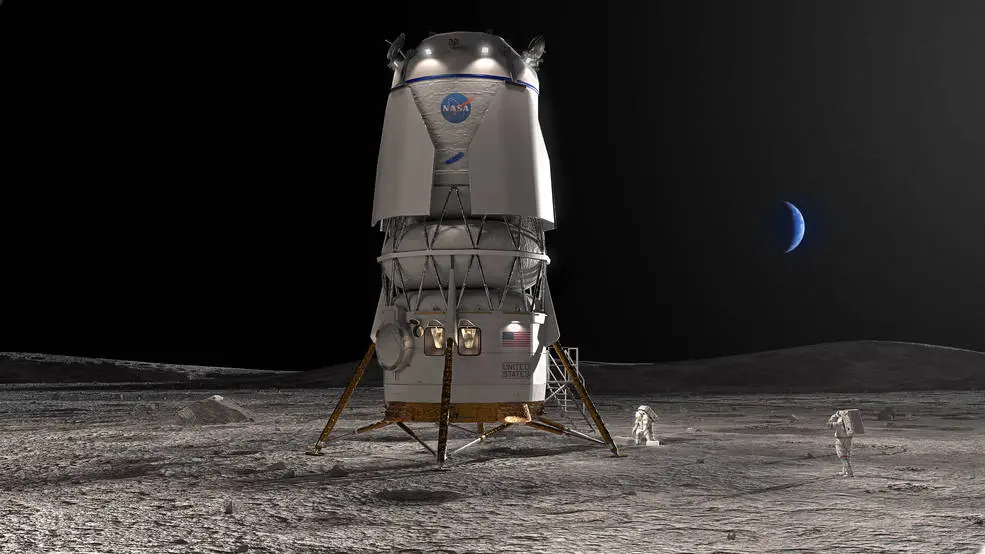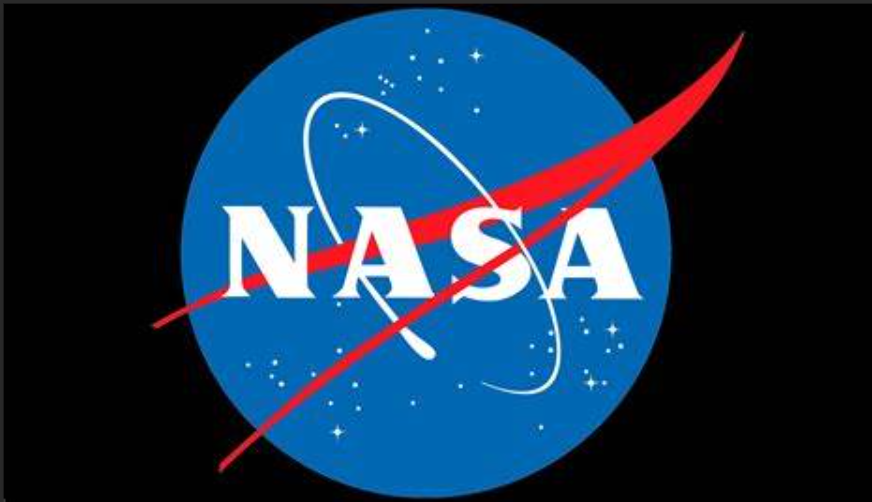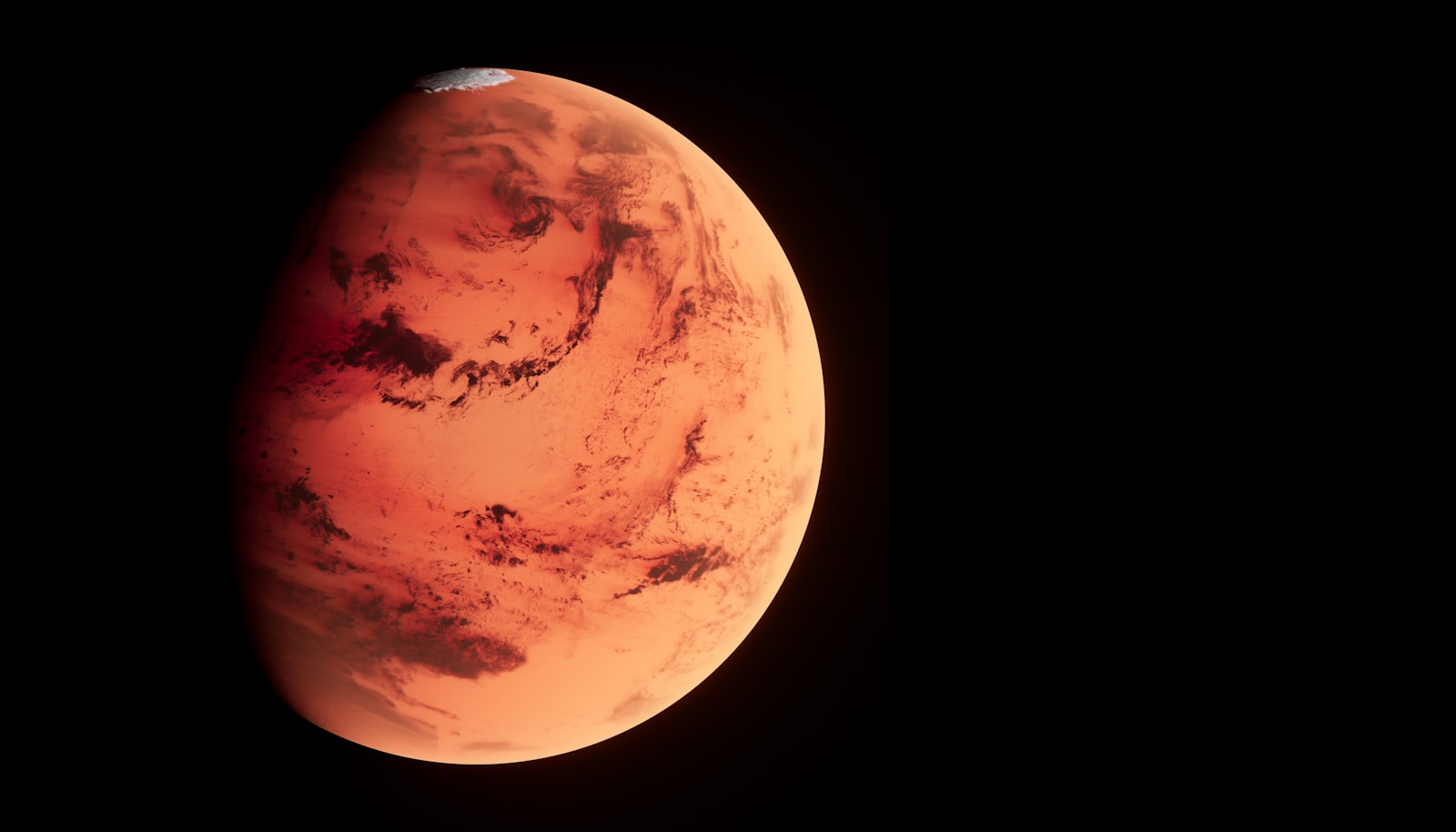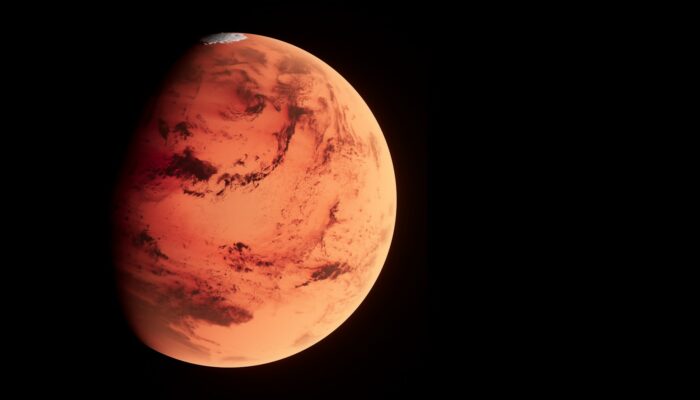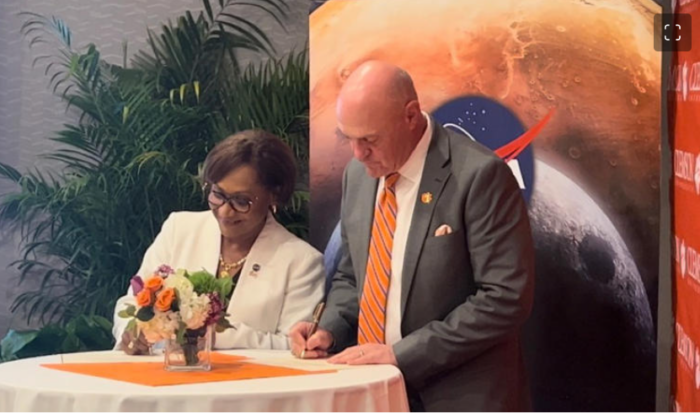by Julia Seibert
Summer 2021: that time when Blue Origin really put their foot in it. The company, usually known for sending tourists on suborbital hops to space, was burned by NASA’s decision to go with rivals SpaceX for its lunar Human Landing System (HLS) design: a prestigious award worth billions of dollars.
Blue was not happy, but complaints to the Government Accountability Office (GAO) and a long-winded open letter from Jeff Bezos himself did nothing. Naturally, a hefty lawsuit against NASA ensued, which – though it ultimately failed – halted development on the chosen design, and thus the US’s lunar plans, for months. The efforts also came accompanied by a snarky, now-infamous infographic highlighting the risks of SpaceX’s design, despite Blue’s lacking spaceflight experience. One can only imagine the plight of the company’s PR department.
Ironically, however, none of that was necessary; in May 2023, Blue Origin was awarded an HLS contract after all. Let’s delve deeper into Blue Origin’s HLS design and the unique journey that led to its acquisition.
Table of Contents
ToggleWhat is Blue Origin’s Human Landing System (HLS)?
Blue Origin’s Human Landing System (HLS), known as “Blue Moon,” is a spacecraft designed to transport astronauts from lunar orbit to the moon’s surface and back. It will serve as a temporary home in the desolate world, supporting the astronauts as they go about their scientific missions. Blue Moon, is one of two designs (the other being SpaceX’s) that have been chosen for NASA’s Artemis program so far.
The Role of Blue Origin within the Artemis Program
For US $3.4 billion, NASA has contracted Blue Origin (and the ‘National Team’, a group of companies that include Lockheed Martin, Boeing, and hundreds of smaller suppliers all led by Blue) to supply a lander to bring humans to the moon for the Artemis V mission. This would be the third landing, as SpaceX’s design will be used for Artemis III and IV. In addition to the human landing, the contract includes design, development, and one uncrewed test run, set to occur a year before the main mission.
For Artemis V, Blue Moon would launch independently of the crew and travel to lunar orbit. There, it would rendezvous with a ‘cislunar transporter’ developed by Lockheed Martin, which would top off the lander’s propellant supply. It would then dock to NASA’s Gateway: a (planned) small space station in lunar orbit intended for scientific research and short-term habitation. Two of the four astronauts arriving at Gateway via the Orion spacecraft would enter Blue Moon and use it to land. After a week or so on the lunar surface, the HLS ferries them back up to Gateway and Orion, with which they would return to Earth.
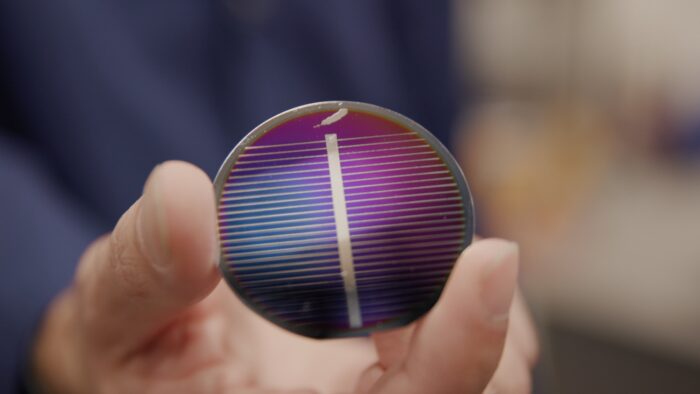
Though its main role in US lunar exploration is providing a landing for Artemis V, Blue Origin has also been granted a smaller contract from NASA to develop its Blue Alchemist project: a method of creating solar panels from lunar soil, or regolith. This is done by a process known as molten regolith electrolysis, where an electric current separates elements present in the soil. Using simulated regolith, the company claims to have created silicon with over 99.999% purity, which solar cells require. Glass, a byproduct of the electrolysis, would protect the cells from the environment. Oxygen is another byproduct and can be used both for life support and rocket propellant. According to the company, the technology ‘could lead to autonomous manufacture of unlimited amounts of solar power, power transmission cables, and oxygen anywhere on the surface of the Moon’.
Features and Design of Blue Origin’s HLS
Blue Origin’s winning lander design stands 16 meters tall. Interestingly, it can fit within the 7-meter-tall payload fairing of their New Glenn rocket, which is currently in development. Powered by the BE-7 engine, Blue Moon runs on liquid hydrogen and liquid oxygen. The propellants are located on the top part of the lander, with liquid hydrogen occupying the large upper tank. The crew cabin, capable of supporting four astronauts, sits at the bottom of the lander, making it easier to enter and exit the vehicle. In its cargo configuration, Blue Moon could bring 20 metric tons to the lunar surface while reusable, and 30 if it stays there. In addition to Lockheed Martin’s refueling vehicle, the design also relies on cooperation from companies including Boeing and Astrobotic for docking and cargo systems.
It is important to note that this design is new; it is not the one that was rejected by NASA in April 2021 in favor of SpaceX, called the Integrated Lander Vehicle (ILV). This lander, unlike the modern design, was modular, with a transfer stage designed by Northrop Grumman, a descent stage by Blue, and an ascent stage by Lockheed.
This is also not to be confused with the very first Blue Moon lander design unveiled by Bezos in 2019 (which prompted some crude wisecracks by rival Elon Musk).
Blue Origin’s HLS vs. Competitors in the Artemis Program
| Starship HLS | Blue Moon | Dynetics HLS | |
| Prime Contractor | SpaceX | Blue Origin | Dynetics |
| Design Approach | Single Stage Lander | Single Stage Lander | Single Stage Lander |
| Crew Capacity | 100 | Four | Two, maybe four (unclear) |
| Payload Capacity | 100 metric tons (reusable) | 20 metric tons (reusable), 30 metric tons (expended) | 12 metric tons (reusable), 30 metric tons (expended) |
| Propellant, propulsion system | Methalox, Raptor engine | Hydrolox, BE-7 engine | Methalox, unnamed engine |
| Planned Launch Vehicle | SpaceX Starship Superheavy | Blue Origin New Glenn | ULA Vulcan or NASA SLS (as of 2020) |
| Development Status | Flight testing ongoing | Not public | Hardware testing and demonstrations |
| Crewed Lunar Landing Contract with NASA | Artemis III
Artemis IV |
Artemis V | None |
See also: Dynetics HLS: Everything you need to know
Blue Origin’s longstanding competitor in the Artemis program – and in general – is SpaceX. Its design is entirely different than Blue’s, consisting of a modified second stage of its Starship rocket, which is still in testing. Like the rocket’s normal configuration, the 50-meter-tall lunar Starship’s payload and crew bay – capable of carrying 100 metric tons to the moon – is at the tip of the rocket. Two tanks of propellant – liquid methane and liquid oxygen – sit in the bottom half. The vehicle is powered by SpaceX’s Raptor engines, but unlike the Earthly Starship, the lunar version has no landing flaps or a heat shield, since these are primed for atmospheric entry on Earth. It also sports landing legs, which the terrestrial rocket does not.
Starship HLS banks on much untested and ambitious technology. The most obvious example is the refueling method, involving multiple tanker Starships filling up an orbital depot, which the HLS would then refuel itself from. The landing mechanism and egress method are also obstacles. Still, it was picked over the 2021 version of Blue’s HLS partly due to its much lower cost; SpaceX’s bid came in at around US $3 billion, while Blue asked for US $6 billion. SpaceX also received higher marks on its overall design.
Another competitor faced by Blue Origin for HLS bids is Dynetics, a subsidiary of defense contractor Leidos. Dynetics, alongside Blue Origin, also lost out on the HLS contract in 2021 and even joined in on the GAO protests after SpaceX’s sole selection. It entered the race for the second lander in late 2022 but was ultimately beaten by Blue Moon.
Dynetics’s HLS, called Autonomous Logistics Platform for All-Moon Cargo Access – or ALPACA – is wide instead of tall, with a crew cabin in the center and propellant tanks on either side. The design also features two long solar panels extending upwards from the roof. The spacecraft could carry four astronauts at a time, but only sustain two once on the surface. Once a mission is complete, the company hoped the craft could remain in lunar orbit, to be reused after receiving new propellant.
However, the proposal was not enough to stop Blue Origin from clinching the win. In a selection statement, Jim Free, Associate Administrator for the Exploration Systems Development Mission Directorate at NASA, claimed that Blue’s design was less risky than Dynetics’s; a better management approach and the price offered by Blue were also factors.
Blue Origin’s Progress in HLS Development since NASA’s Selection
When Blue Origin (and the National Team) was first selected by NASA in April 2020 alongside SpaceX and Dynetics for design development, its HLS was very different from today’s concept. This was the ILV, which consisted of three stages, each built by a different company. It had the crew cabin and ascent stage on top, with the descent stage and its propellant tanks at the bottom. It also featured a transfer stage that would lug the lander into lunar orbit to prepare for landing. Unless it launched on NASA’s massive SLS rocket, these stages would have had to be launched separately.
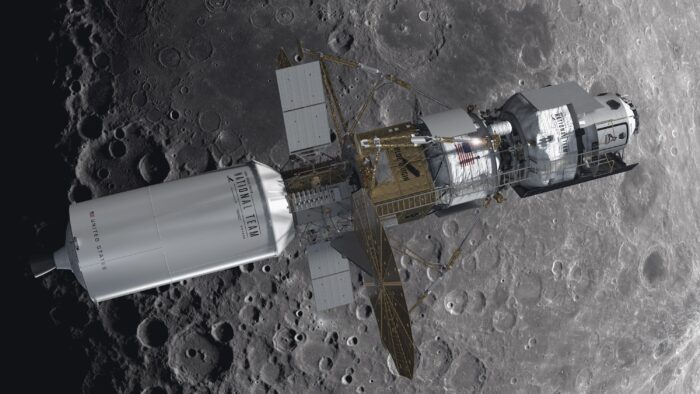
Part of ILV’s appeal was that instead of just one company running the show, the design called for the cooperation of hundreds, including both big defense contractors and smaller businesses. As a result, the economic benefits from a NASA contract would be spread across the country and not concentrated in one company or area (this is still the case with modern design). NASA also noted that much of the ILV’s technology relied on flight-proven space technology. The transfer element, for example, was based on Northrop Grumman’s Cygnus spacecraft, while the ascent stage was reminiscent of Orion’s crew module, which Lockheed is the prime contractor for.
However, NASA’s SLS rocket already provided many of these benefits, and the agency now had less cash to throw at a lander. After the ILV design was lost to SpaceX in April 2021, Blue Origin first got the frustration out of its system by complaining and suing (and making passive-aggressive infographics). NASA’s rejection then prompted Blue to quite literally turn the design on its head for its second attempt to win a contract. The crew cabin is now at the bottom and the vehicle of a more manageable single-stage design. More strikingly, the lander was now a single-stage design. The BE-7 engines are also likely to have seen some development since 2021. Still, as this updated version of the lander was selected in May 2023, it might be too early to discern any significant developments since then.
Blue Origin’s HLS Missions and Objectives
Crunchtime for Blue will be 2029, the year Artemis V is currently scheduled for. However, several important developments must happen (preferably successfully) before then. Now that Artemis I (an uncrewed lunar flyby to test the SLS rocket and Orion spacecraft) has been completed, Artemis II is next on the list. Planned for late 2024, this will be the first crewed Artemis mission, with astronauts Reid Wiseman, Victor Glover, and Christina Hammock Koch of NASA – plus Jeremy Hansen of the Canadian Space Agency (CSA) – to fly by the moon in Orion. Adjacently, SpaceX should be getting around to its uncrewed landing demo, though it remains to be seen if Starship will be ready by then.
This will be followed by Artemis III, theoretically the first of the landing missions. If there are no delays – which, given the program’s track record, is unlikely – it will take place in 2025. Four astronauts (not yet chosen) will fly to the moon in Orion. Two of them will enter Starship and spend a few days on the moon before coming back. If Starship is not ready, NASA is considering pushing the mission to 2026, or keeping the date and canceling the landing part. Meanwhile, Blue Origin has proposed performing some smaller ‘pathfinder missions’ in 2024 and 2025 to mature certain technologies before go time.
Another landing should occur with Artemis IV in 2028, also using Starship. This time, Orion and Starship will dock to Gateway, which should be operational by then. Starting with this mission, the next few flights will continue to build out the station.
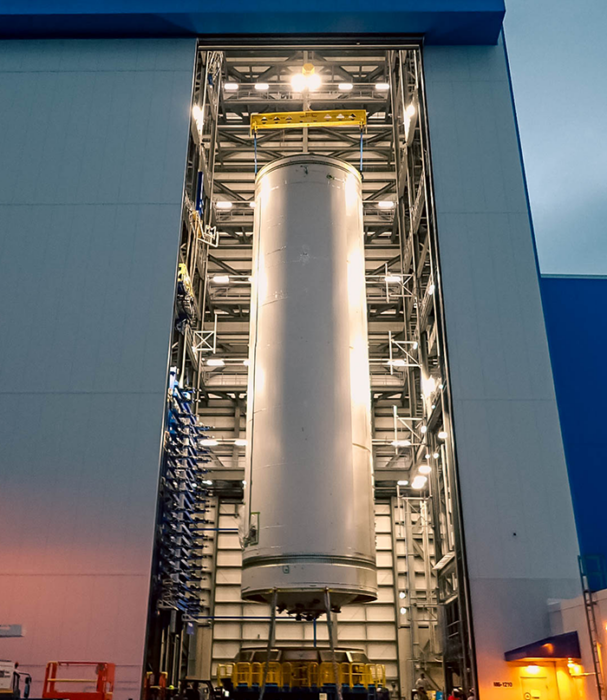
Then it is Blue’s turn. As SpaceX completes its second landing and Gateway becomes operational, Blue Moon (and perhaps New Glenn) will perform its demonstration flight. Blue Origin is going the extra mile by testing extra components of the lander, including life support systems, as opposed to just the landing as demanded by NASA.
In 2029, the real mission begins. If all goes well with Gateway, the SLS and Orion will bring the crew to the station, which Blue Moon will be docked to. Then, two astronauts will spend a week on the moon, sustained by the lander, before coming back to orbit.
The next missions, set to take place yearly, will see further building out of Gateway as well as the first attempts at long-duration stays. These might include some manufacturing, construction, and local resource utilization. Still, the lander role for missions beyond Artemis V is up for grabs – and there is a reason for that. According to Lisa Watson-Morgan, manager of the Human Landing System Program at NASA’s Marshall Space Flight Center, the goal of the commercial HLS program is to foster competition between companies. ‘This competitive approach drives innovation, brings down costs, and invests in commercial capabilities to grow the business opportunities that can serve other customers and foster a lunar economy,’ she says.
See also: How are we going to colonize the Moon?
Challenges and Solutions in Blue Origin’s HLS Development
Blue Origin’s HLS design, as noted by Ars Technica, is not quite as out there as SpaceX’s Starship, which looks like it stepped out of a sci-fi comic. Still, getting Blue Moon operational requires its fair share of technological leaps. One of them is fixing the problem of liquid hydrogen boiloff, a conundrum that haunts rocket scientists’ dreams. The chemical has a liquefication point so low it is only a few degrees over absolute zero. Due to space’s wildly varying temperatures, spacecraft using hydrogen only have a day or so to use it up before it boils away. Blue is hoping to keep its lander on the moon for around a week (longer if it wins further contracts featuring more ambitious mission profiles), and stranding astronauts on the rock with no fuel might prove problematic. As such, solving the boiloff issue is likely at the top of Blue’s list. The 2023 source selection statement also notes concern regarding the communications system and the proposed schedule, the latter of which ‘contains numerous conflicts and omissions’ that could lead to confusion and delays.
Getting Blue Moon up to scratch, which also includes testing out cislunar refueling, is a tall order in itself. However, the lander has been tailored to fit Blue’s New Glenn rocket, a partially reusable heavy lifter originally scheduled for a 2020 debut that has not yet left the hangar.
There are a few reasons why the rocket is dragging its feet, including its perpetually delayed engines, but the underlying theme seems to be that Blue has zero experience with putting things into orbit. Its only operational rocket, New Shepard, occasionally ferries tourists into suborbital space and back within ten minutes. While it gains some brownie points for a self-landing booster, it is a far cry from the trials and tribulations of orbital rockets – not to mention gargantuan moon-bound monsters. Even SpaceX, the current kingpin of orbital launches, is experiencing its fair share of trouble with Starship, and it has been testing that for years. With New Glenn yet to complete a single test and Blue’s ambitions spread thin across a variety of space-related niches, the company must get their skates on fast if it wants to make the launch date.
You may also like:
- How much does it cost to launch a rocket?
- How Much Does Rocket Fuel Actually Cost?
- Top 6 SpaceX’s Goals and Objectives
Conclusion
Blue Origin’s HLS is still a ways away from launching anything into orbit, much less a lunar lander. However, the significance of Blue Origin’s participation in the HLS program lies in NASA’s justification of the competitive approach. Right now, NASA – and a good chunk of the spacefaring world – is massively reliant on SpaceX. The company accounted for 79% of mass launched to orbit in 2023’s second quarter, sending up a rocket every few days. In addition, nothing in the space industry compares to SpaceX’s Starship, which – if and when it becomes operational – could send out entire lunar colonies with just a few launches.
This SpaceX monopoly monopoly gives the US an upper hand in space matters at the moment, but it might be hard to control further down the line. Meanwhile, NASA knows that its own capabilities, hobbled by budgetary and political restraints, cannot compete. Fostering competition instead might give SpaceX a run for its money and somewhat stifle its chokehold on the industry.
The involvement of Blue Origin in this competition could prove to be a game-changer, depending on its ability to secure and deliver on HLS contracts. However, if it doesn’t succeed, another confrontational infographic campaign might be in the offing.
If you found this article to be informative, you can explore more current space news, exclusives, interviews, and podcasts here.
Featured image: Artist’s concept of the Blue Moon lander. Credit: Blue Origin
Share this article:
